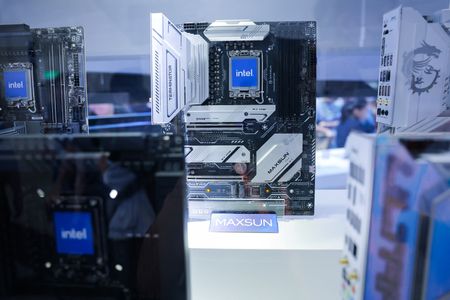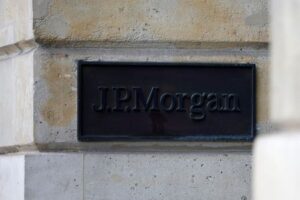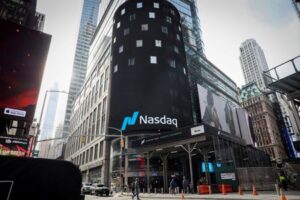By Noel Randewich and Arsheeya Bajwa
(Reuters) -Intel shares sank 26% on Friday in their worst day since 1974 after the chip manufacturer suspended its dividend and slashed its workforce to fund a costly turnaround after losing its once-dominant global position.
The company lost more than $30 billion in market value after it gave a disappointing forecast and said it would cut 15% of its workforce, deepening worries about its ability to catch up with Taiwan’s TSMC and other chipmakers.
The stock ended the day at $21.48, its lowest since 2013.
“Intel’s issues are now approaching the existential in our view,” Bernstein analyst Stacy Rasgon said.
Rasgon said Intel could add $40 billion in cash to its balance sheet by the end of 2025 through the moves, as well as subsidies and partner contributions.
While Intel’s manufacturing setbacks are specific to the Santa Clara, California-based company, other chipmakers also sank for a second straight day.
Weak employment numbers on Friday caused a sharp increase in worries about a slowdown in the U.S. economy, leading traders to bet that the U.S. Federal Reserve will deliver a big half-percentage-point rate cut in September, instead of a 25-bp cut expected before the data.
“The excitement over AI and large cap technology is coming back to earth. The future is still bright, but the truth is investors got a tad too excited and once again, we see when everyone gets on one side of the boat what can happen,” said Ryan Detrick, chief market strategist at The Carson Group.
Companies selling equipment used in factories run by Intel and other manufacturers fell sharply, signaling investor concerns about the pace of future investments in manufacturing infrastructure. Applied Materials, ASML Holding and KLA Corp all dropped around 8%.
The PHLX chip index sank 5.2%, bringing its loss this week to almost 10%.
Nvidia dropped almost 2%, with the dominant seller of AI processors down over 20% from its record high close on June 18.
Heightened worries about a recession, along with quarterly reports from Amazon and Alphabet that failed to impress Wall Street, have fueled doubts about the future pace of investment in AI, said Ross Mayfield, an investment strategy analyst at Baird.
“There’s a broader question of whether this AI capex can continue basically vertical or exponential growth, especially if the macro backdrop is softening,” Mayfield said.
‘FORGOTTEN HORSEMAN’
Intel was once the world’s leading chipmaker, with the “Intel Inside” logo a valuable marketing feature on personal computers in the 1980s and 1990s.
Part of the dotcom era’s Four Horsemen – along with Cisco Systems, Microsoft and Dell – Intel’s stock market value peaked at nearly $500 billion in 2000 before slumping that year and never recovering.
It continued to dominate in brawny PC chips, but was caught off-guard by the launch of Apple’s iPhone in 2007 and other mobile devices that demanded lower power and less pricey processors.
Now valued at about $91 billion, Intel is worth less than 5% of Nvidia and about 40% of Advanced Micro Devices’, two PC chipmakers it loomed over for decades until recently.
“Intel has been one of the forgotten horsemen of technology the last couple decades – never overtaking its year 2000 highs and struggling to get earnings back to where they were before the AI revolution,” said Michael Schulman, chief investment officer of Running Point Capital.
Its server chip business has been taking a hit for several years as companies prioritize spending on AI chips, where it lags Nvidia, which has become one of the world’s most valuable firms thanks to booming demand for its processors.
To regain its manufacturing edge, Intel plans to spend $100 billion across four U.S. states to build and expand factories after securing $19.5 billion in federal grants and loans.
The company told investors on Thursday it remains “comfortable” with those CHIPS program plans.
Intel’s turnaround plan depends on persuading outside companies to use its manufacturing services. But analysts said the push to energize the business could take years. For now, it is increasing Intel’s costs and pressuring profit margins.
Intel’s unsecured bond that offers a coupon of 5.15% and is due in 2024 was trading 20 basis points wider on Friday, way above bonds of other companies, according to investors. Its 5.6% unsecured bonds due in 2054 also widened by 17 basis points.
The higher trading volume compared to other bonds was due to Intel’s recent earnings report, bond market participants said.
“That’s weighing on bond trading,” said Dave Novosel, senior investment analyst at corporate bond research firm Gimme Credit. “They see that they may need to come back to market for a modest amount of debt.”
(Reporting by Noel Randewich in Oakland, California, and by Arsheeya Bajwa and Aditya Soni in Bengaluru; Additional reporting by Matt Tracy in New York and Arsheeya Bajwa in Bangalore; Editing by Arun Koyyur, Will Dunham and David Gregorio)





